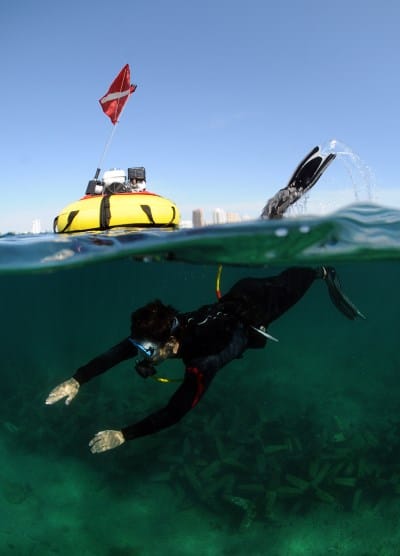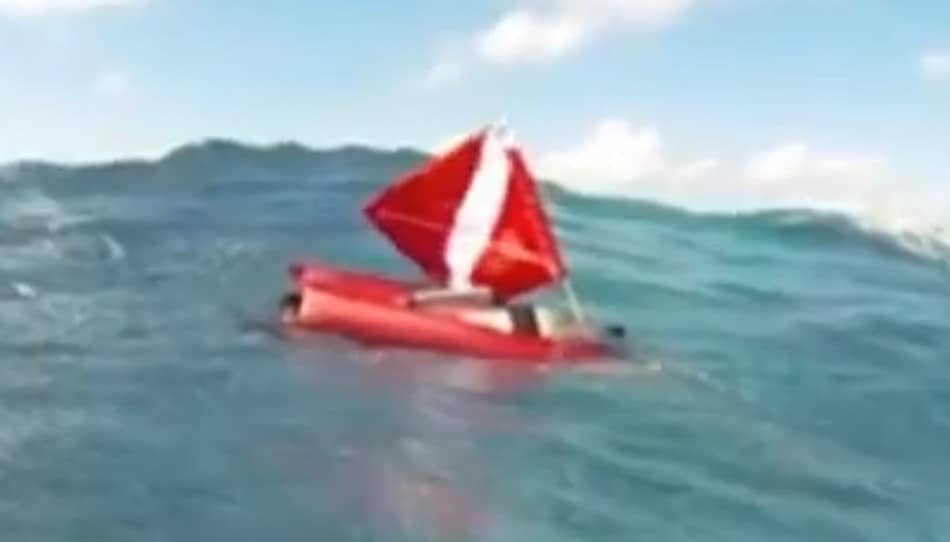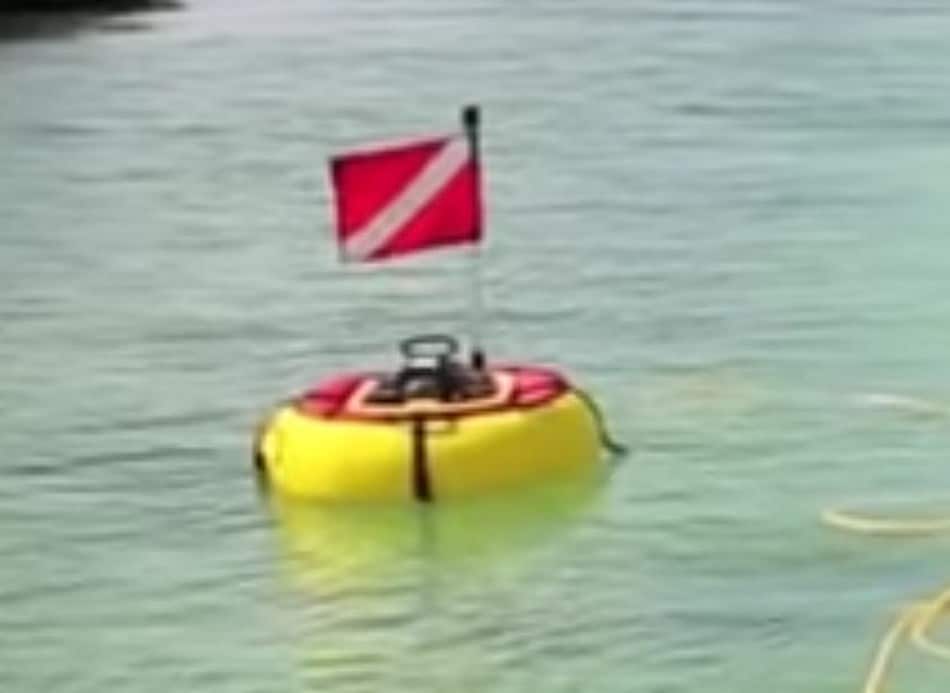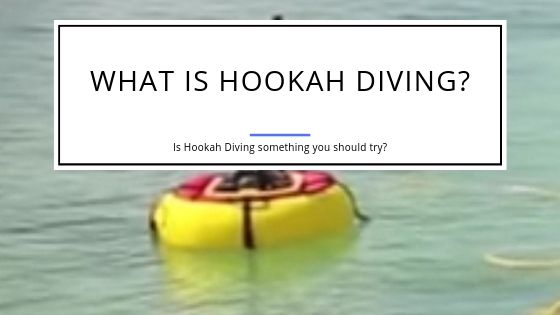What Is Hookah Diving?
Traditional scuba diving is for individuals who like to roam around freely in deep waters without limiting themselves. Hookah diving is the ideal option for divers who don’t want to carry the whole SCUBA air system with them while being submerged in a restricted zone of water for long periods.
What is Hookah Diving? It’s basically scuba diving while you’re attached to a hose that supplies the air instead of using tanks with compressed air. You can only dive as deep as the hose is long. The advantage is that you can dive for longer periods of time as you’re not depending on how much air you have in the tank!
With Hookah diving systems, the diver doesn’t need to wear any high-pressure air tanks on their back. Instead, a small-sized air compressor is placed at the surface of the ocean which conventionally receives power by a portable gasoline engine or an electric motor. The diver receives the air through a floating air hose that connects to the helmet.
With such a hookah system, the diver has a never-ending and almost free-of-cost supply of air. The air flow would only stop if the gasoline engine or the motor that powers the air compressor fails to operate. This air system is quite economical when compared to the expense it takes to refill a SCUBA tank after every hour or so.
Why Consider Hookah Diving? – What Are the Advantages/Disadvantages and Limitations?
If you have excelled at swimming and have become an expert at snorkeling, then it’s time to explore the ocean just below the surface a tad bit more by considering hookah diving.
With a hookah diving system, you can dive deeper into the ocean; go up to 90 ft below the surface, and that too for longer periods! Unlike traditional scuba diving, you won’t have to resurface for air or go through the hassle of lugging around heavy air tanks.
Advantages of Hookah Diving
Here are some of the benefits that hookah diving offers in general:
Safety
When compared with scuba, hookah diving is ideal for newbie divers from a safety perspective. Because of its lightweight nature, the movements of the divers remain restricted to the surface, making it impossible for them to dive too far below the surface. This can be a life-saving advantage for Hookah systems.
Prevention from Diver’s Disease
Because of being tethered to the surface, hookah divers don’t have to face the potential risks of diver’s disease. Also known as decompression sickness, diver’s disease is caused by the dissolved gases that are released from the body of the diver during depressurization i.e. when they are ascending to the surface.
Studies suggest that decompression sickness is indeed possible in hookah divers. But as the length of the air umbilical cord used in hookah diving prevents them from going too deep in the water, they remain protected from the extreme effects of decompression sickness.
Keeps Divers Close
Since hookah divers are required to stay close to the surface of the ocean, it keeps all the divers within eyesight of each other. Not only do Hookah systems encourage a safer environment but also provide a more social form of diving which isn’t the case with scuba.
Protection from Caves
This is a well-known fact that cave diving is very risky and dangerous; therefore, it should only be attempted by professional divers. Due to the limitations of hookah umbilical hoses and their inability to not go far enough to reach an underwater cave’s depth, hookah divers are restricted from entering them.
The same goes for wreck diving. Exploring the wreckage of ships, aircraft, and other similar artificial structures can be difficult as the use of the umbilical cord restricts the divers from reaching areas far away in the ocean that they can reach and explore with traditional scuba diving.

Disadvantages of Hookah Diving
Like all other diving forms, there are some disadvantages to hookah diving.
Punctured Air Hose
A punctured air hose is always a potential danger when you hookah dive. The air systems are manufactured with high-density vinyl and nylon, and both the materials are prone to punctures. Therefore, there is never 100% guaranteed safety from aquatic-life attacks.
Limited Exploration
The length of the umbilical cord plays an important role in your hookah diving experience but it can limit your exploration. The hose only lets you extend to a certain depth. You might find something interesting underwater and desire to see it up-close but with a hose that is not long enough, you can’t reach your desired destination.
Dangerously Hot Air Temperatures
Hookah air is believed to reach extremely high temperatures sometimes. A reserve tank works as a cooling and condensation vessel. As the air enters it, it expands and cools down.
Different Types of Hookah Diving Systems
There are two types of hookah dive systems. A hookah dive system is either powered by gasoline or electricity. Each type comes with its share of pros and cons and we’ll highlight them in the section below.
Gasoline-Powered Hookah Diving System
The gasoline powered Hookah diving system is probably the most commonly seen and used. It’s easy to come by and will run without any problems until you run out of gas and it can’t pump air anymore.
Pros
- Has a relatively prolonged life
- More efficient, with 3 hours of diving time on less than one gallon of gas
- Cost-effective
Cons
- Cannot be used without a gasoline source
- Requires extra maintenance
- Noisy
Electric-Diving Hookah
Not only do you see more and more electric cars, you will also find a growing number of electric Hookah dive systems available. They are great until you run out of battery and need to recharge.
Pros
- Cleaner and requires lesser maintenance
- You can recharge it using the power source of your boat
- All you need to do is switch a button on to start it
- Makes less noise than gas units
Cons
- Requires an external energy source
- Can be more costly than gas units

How Does It Work?
Hookah, also known as surface-supplied air diving, is not like your usual snorkeling. It is actually much more complex than that. A Hookah diving system uses sophisticated and advanced equipment to provide each scuba diver with a safe experience and a reliable, suitable supply of oxygen.
The Helmet
Hookah dive systems are heavy-duty, safe, and reliable, make use of a helmet that is connected to the surface system through a cord called an umbilical hose. While a snorkel lets air pass through a non-return valve and lets it flow into the lungs of the scuba diver, such is not the case with hookah diving systems.
In this hookah system, the level of atmospheric pressure in the helmet should match the pressure of air from the surface. Otherwise, the air supply will get blocked by the forced build-up. For this reason, the attendant hose of the helmet and the helmet itself feature multiple exhaust valves.
Because of those valves, the pressure of the hookah system can be adjusted in accordance with the depth of the hookah diver in real-time. In result, the oxygen supply gets to flow freely according to the needs of the diver and the pressure they are diving at.
The Reserve Tank
Professional hookah divers use reserve tanks of oxygen gas for emergency purposes. They carry it with them while diving. These tanks are used to provide them with oxygen and they get refilled continuously through the air compressor located at the surface of the ocean.
Many people are not aware of the fact that hookah air can sometimes reach very high, dangerously hot temperatures. A high-quality and properly functioning tank ensures the cooling of the airflow so that it becomes appropriate for the diver to consume.
The Compressor System
Lastly, the hookah compressor system is the most fundamental unit of the whole diving gear. It remains on the surface of the ocean and gathers air from the surrounding atmosphere. As mentioned above, the hookah air compressor receives its power from either a gasoline engine or an electrical source.

Do You Need Special Certification for Hookah Diving?
No Training Required
Scuba diving demands thorough, in-depth training and certification. However, hookah diving can be performed without going through any kind of schooling. Going through some degree of training before attempting a hookah dive is strongly recommended.
There aren’t any institutes offering hookah diving certifications at present. However, you can take The Air Line by J Sink’s Hookah Training Home Study Course to gain relevant knowledge.
As usual, try small steps instead of overdoing it when you start it. Learn how the hookah system works and how you can safely dive with it before trying any potentially life-threatening excursions. Hopefully, we’ll see some hookah certifications be introduced in the future that match what we know when scuba diving.
Can Hookah Diving Be Used for Recreational Divers?
Surface Supplied Air or Hookah for recreational divers has been gaining popularity in various locations all around the world. As discussed above, this activity doesn’t require any special training or certification which makes it convenient for the divers.
How Much Does It Cost?
Once you buy a hookah system, the only extra cost you’ll have to worry about is the fuel since the majority of hookah air compressors are powered by gasoline engines.
Even if an electrical motor is the power source for your compressor, you can enjoy a cost-free air supply until your power source runs out of battery. The cost of these systems ranges from $1500 to $5500 but the experience is definitely worth it!

